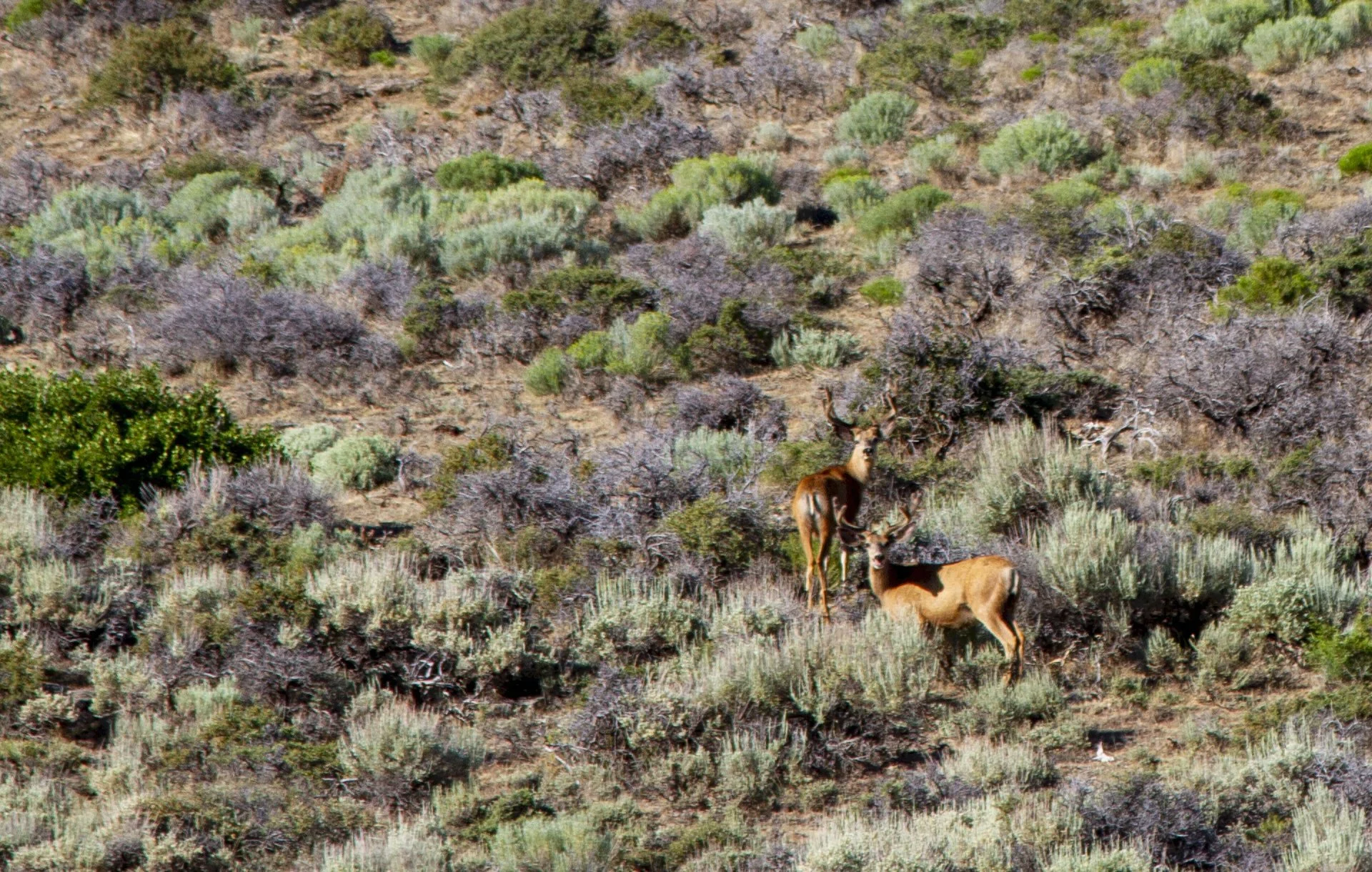Best States To Hunt Mule Deer
This article was originally published on hunttoeat.com in September of 2021.
Few articles with this title get at the essence of why someone would embark on a mule deer pursuit. Whether you live out west or are traveling to a mule deer-filled state, starting out can seem daunting. You need to invest a lot of effort in skills development, time, and money to hunt grey ghosts. Here is a starting point for planning and preparing for your mule deer hunt.
As with many big game conservation stories, the regulation of hunting at the turn of the 20th century restored mule deer populations. They were on the brink of extirpation from the lower 48. Then, with a combination of conservation efforts, successional forest regrowth from logging, and better edge habitat from a variety of human activities, their populations roared back in the mid-1900s.
Many see the ’60s, ’70s, and some of the ’80s as the “Golden Years” for the beloved mule deer. However, with changing climate, increased development on crucial winter ranges, and a host of other factors, mule deer populations around the West continue to wane from their traditional highs. As a result, anyone who seeks these Western icons has found fewer deer, and greater competition for the few opportunities to hunt them.
What does this mean for the hunter hoping to get into mule deer hunting?
First and foremost, planning is everything. If someone started their search for a mule deer hunting opportunity in August, they would be mighty disappointed. Some of the iconic mule deer states like Nevada, Montana, and Utah are experiencing a lack of hunting options.
Each state has its own challenges, upsides, and adventures available to the eager mule deer hunter. It’s more crucial than ever to do your research on biological and conservation issues by state. For instance, Arizona’s historic drought of 2021 likely will have an impact on deer numbers well into the future. Some Wyoming deer herds are still rebounding from the winter of 2016-2017. As such, hunting opportunities for nonresidents have remained stymied to allow for more bucks to rebound on the landscape. On the other side of the coin, Colorado is increasing opportunities to hunt mule deer as a result of new scientific studies demonstrating that that hunting pressure helps control Chronic Wasting Disease (CWD).
This guide gives you a brief look into the types of hunting available for mulies across the West. It’s especially intended for someone getting started. You will not find trophy unit recommendations or Boone and Crockett scores here. There are better-suited authors for that information. However, if you are looking for an adventure next year while enjoying the great outdoors in pursuit of mule deer on the table, here are a few things to consider.
The Best State For: Filling The Freezer
Indulging in perfectly seared backstraps of last fall’s mule deer can carry one through the off-season. If you want to get into mule deer hunting and have some of the best chances of putting one in your freezer, no state offers more licensed deer hunting opportunities than Colorado, and for good reason: no Rocky Mountain state has more mule deer than Colorado.
Few states seem to receive as much love and as much hate as Colorado. The views while hunting are incredible, with gorgeous aspens nestled under snow-capped 14-ers. Mule deer are generally plentiful where there’s a lot of opportunities. That said, so much opportunity and over-the-counter elk seasons present some crowding issues.
You can hunt mule deer every fall in Colorado. There, the deer migrate out of the mountains and onto winter range. There are three rifle seasons running around a week in length starting at the end of October. These seasons can put deer on their feet later into the morning and earlier in the afternoon. This makes it just a touch easier for novice mule deer hunters to find a legal deer. Archery and muzzleloader hunters can find even more consistent hunting opportunities in September.
I drew a second-choice deer tag in 2020 that offered over 40 percent harvest success rates. Wyoming’s general deer hunts averaged 30 percent harvest rates in 2020. Other states with higher harvest rates do not guarantee a license for next year. For example, Montana has a 56 percent nonresident success rate. If you are wanting to chase mule deer and are most concerned with having a cooler full of free-range venison from the Rocky Mountains, there are few better options than Colorado. Do not forget to apply next spring!
Learn more about hunting Colorado.
The Best State For: The Poor Planner
I’ve scoured the web, Facebook, and many hunting forums. I often find a plethora of folks who want to go hunting for mule deer without much pre-planning. If these folks hunt mulies with a rifle, muzzleloader, or archery equipment and are knocking on the season’s doorstep, then the prairies of western Nebraska are the first place to consider.
After hunting the Cornhusker State for mule deer during rifle season, I know public land and public access areas are more crowded than an all-you-can-eat night at the local steakhouse. All joking aside, my experience in the state is one where the short rifle season drives congestion in the field, especially on opening day. By contrast, the primitive weapon seasons were pleasant, with a lot of mule deer around to pursue.
The over-the-counter archery season runs from September 1 through December 31. There’s a one-week rifle season in November and a month-long muzzleloader season in December.
Again, the rifle hunting pressure is immense on publicly accessible land. The age class of mule deer there is nothing you’ll hear about in trophy hunting magazines. However, it is a great place to get your feet wet practicing your glassing skills and pursuing mule deer with your choice of weapon. This is especially so if you do not live in a state with mule deer hunting opportunities.
Learn more about hunting Nebraska.
The Best State For: Archery Hunting Mule Deer
If you ask the locals, Arizona’s vast deserts and high mountains have found themselves holding noticeably more mule deer than 20 years ago. Although the 2020 and 2021 drought cycles will hurt populations, the consummate archery hunter will find plenty of opportunities here for both mule deer and Coues whitetail deer.
You can walk into the store and buy a tag over the counter in this state. With that license, you can hunt in January of that year, a 30-day season that kicks off at the end of August, and again in December as the rut is turning on. It’s important to note that this season recently changed. These hunts are popular. A handful of the over-the-counter archery seasons changed to limited seasons, Coues-only seasons, or got eliminated. With the future unknown, now is definitely the time to be looking at Arizona.
The August season occurs when deer are in their summer patterns and usually sport velvet racks. The December and January seasons occur during the rutting period for mule deer and Coues deer. This split gives an eager hunter the opportunity to come out and hunt twice in a year during two vastly different times in a mule deer’s biology. Most folks elect to sit over water holes frequented by deer or try their hand at spot and stalk strategies. Both are undoubtedly tough in the various landscapes offered by Arizona. However, if you want to hone your archery skills year in and year out, look to this state.
Learn more about hunting Arizona.
The Best State For: Learning to Hunt Mule Deer
I currently reside in the Cowboy State, so I’m biased. To me, there are fewer states that set you up for learning mule deer behavior and honing your skills like Wyoming. Wyoming offers rifle seasons in regions and limited quota units around the state. Some of those regions are huntable every year through the June application. Others demand more than a half-dozen years of preference point building to experience them.
October rifle seasons are preceded by a September 1-30 archery season that a hunter can participate in by simply purchasing an archery stamp. Why is Wyoming a great state to learn mule deer in? Because there are areas you can return to regularly and learn mule deer behaviors in some of the more difficult times of the year to hunt them. Plus, the opportunity to archery hunt and return again in the same year with a rifle gives someone the one-two punch of honing their stalking stills with a bow followed by a generally better chance at taking home a deer for the freezer.
Mule deer numbers are struggling in many areas of Wyoming. However, that is not always the case in the areas that offer yearly nonresident opportunities. Tags are usually easier to come by in areas with more private land. However, a good GPS system coupled with Hunter Management Areas and Walk-In Access programs administered by the Wyoming Game and Fish Department means mule deer are accessible in every unit and region in the state.
The key to success in these Wyoming hunts is to dedicate your mule deer hunting efforts to an area. Scout it, learn the deer, and immerse yourself in the process of finding mule deer bucks in their October hidey-holes.
Learn more about hunting Wyoming.
Parting Thoughts
If you take nothing else away from this list of best states, remember to enjoy the process. Hunting mule deer is not easy, no matter what your aspirations are for the hunt. Whether the future is bright for mule deer hunting is a question best left for Nostradamus. That said, there are a lot of opportunities for pursuing the grey ghost today. That’s something to cherish.
If you can, lend a hand to an organization working on mule deer conservation. Please consider giving back to keeping these incredible icons of the West around. Whether Mule Deer Foundation, Muley Fanatic Foundation, or a state-wide conservation organization, there are great people out there helping keep mule deer migrations intact, improving mule deer habitat, and reducing the human negative impact on this incredible species.
As lovers of these wildlife and wild places, it never hurts to pay it forward.


